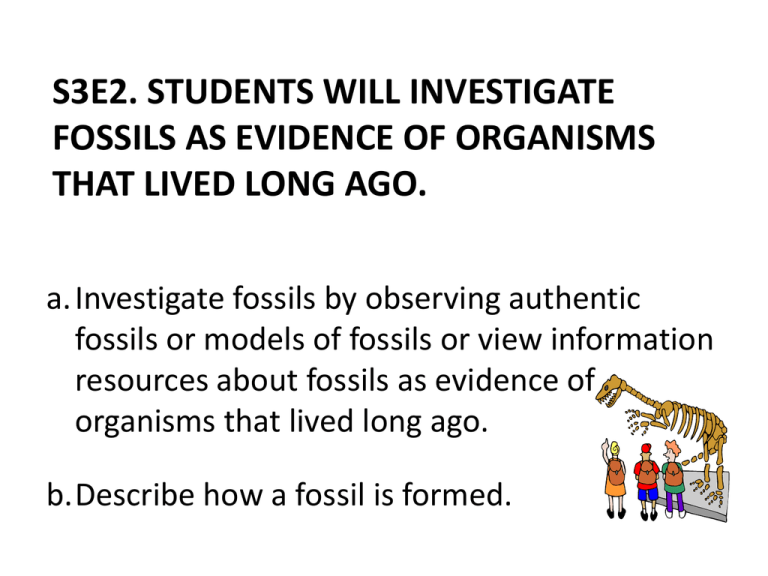S3E2 Fossils intronew
advertisement

S3E2. STUDENTS WILL INVESTIGATE FOSSILS AS EVIDENCE OF ORGANISMS THAT LIVED LONG AGO. a. Investigate fossils by observing authentic fossils or models of fossils or view information resources about fossils as evidence of organisms that lived long ago. b.Describe how a fossil is formed. Fossils are more than Dinosaur Bones! What can turn into a fossil? The Day the Mesozoic Died The disappearance of the dinosaurs at the end of the Cretaceous period posed one of the greatest, longstanding scientific mysteries. The story is shot on location in Italy, Spain, Texas, Colorado and North Dakota. The film traces the uncovering of key clues that lead to the stunning discovery that an asteroid struck the Earth 66 million years ago, triggering a mass extinction of animals, plants, and even microorganisms. Need Images? http://www.paleoportal.org Fossil Misconception Misconception: Fossils are pieces of dead animals and plants. Fact: Fossils are not actually pieces of dead animals and plants. They are only the impression or cast of the original living thing. The actual living parts decay away but their shape is permanently recorded in the rock as it hardens. What is the difference between a bone and a fossil? The bone has been replaced by minerals in a fossil. The bone has become a rock. Collecting Important Data Map the grid. Measure the find. Record the information. Include date, location, and conditions. The position is important to understanding how the animal lived and died. Classroom Dinosaur Dig Each group gets the materials. Probe each area with a toothpick to locate possible dinosaur evidence. Mark where to dig on the grid map. Decide which grid to excavate. Slowly and carefully use the spoon to uncover the discovery. Record data in your journal and sketch what you found. In this illustration of a Tyrannosaurus rex specimen called Bucky, the shaded areas represent actual fossils. The remainder of the skeleton is made of casts taken from other T. rex fossils. Bucky is considered to be the sixth most complete T. rex ever discovered. A complete dinosaur skeleton is a rare find. Imprint, Mold and Cast Fossils This rare imprint of Edmontosaurus skin was a significant discovery on The Children’s Museum’s 2003 Dino Institute Teacher Dig in South Dakota.The fossil indicates that the dinosaur may have had scaly skin, but it provides no clue about its color.





